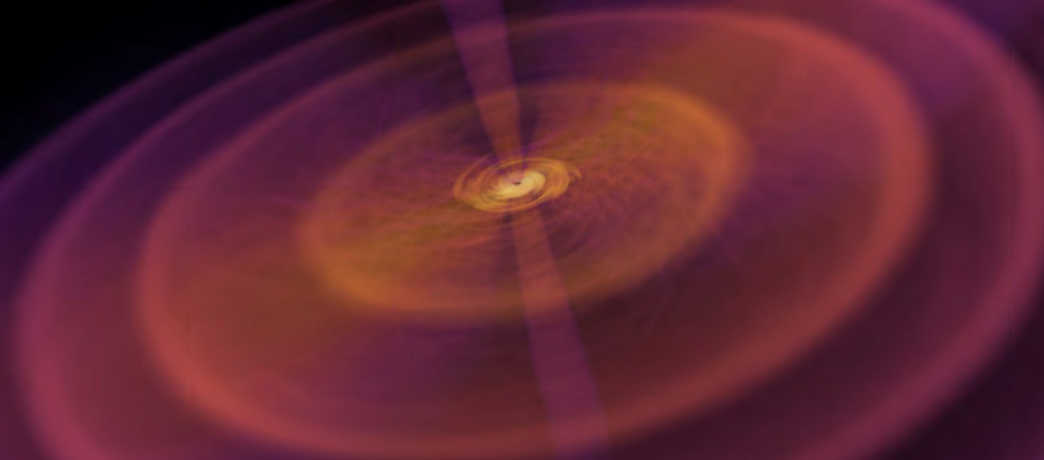Processors and plasmas

Snapshot from a black hole simulation showing matter rapidly accreting and spiraling toward the center (yellow). (Image: Lizhong Zhang, Chris White, Kyle Felker, AthenaK Development Team, ALCF Visualization team.)
Kyle Felker’s job can be as unpredictable as the hot, violent plasma he studies. As a computational scientist at Argonne National Laboratory, he helps scientists plan and execute research projects on Aurora, the lab’s new supercomputer. He might be helping researchers simulate a black hole one day and a human brain the next, all while conducting his own research applying artificial intelligence to plasma physics.
Felker relishes his work at the leading edge of computational science. “Every five to 10 years, you’re getting a machine that’s never been seen before,” he says. “Each one has some mix of characteristics that makes it very challenging to work with, like a very new puzzle that everyone’s trying to bring their science to.” His career grew directly out of his experiences as a Department of Energy Computational Science Graduate Fellowship (DOE CSGF) recipient from 2014 to 2018.
Felker fell in love with supercomputers as a University of Chicago undergraduate, where he wrote code to simulate neutrons’ movements in nuclear fission reactors for Argonne’s Intrepid supercomputer. During his Princeton University Ph.D., he contributed to open-source astrophysics code that his advisor, James Stone, and other astrophysicists use to study black holes on Oak Ridge National Laboratory’s supercomputer, Frontier
For his DOE CSGF practicum in 2016, Felker worked with physicist William Tang at the Princeton Plasma Physics Laboratory, modeling how plasma behaves in a nuclear fusion reactor. Felker continued that work as an Argonne postdoc and now as a staff scientist.
When he arrived at Argonne in 2019, the lab was planning and building Aurora, which was made available to the research community in January 2025. Among the world’s fastest supercomputers, Aurora fills the equivalent of four tennis courts and can perform more than one quintillion — a billion-billion — calculations per second. When launching these new, powerful computers, the lab’s team tests them by working on difficult science problems that would benefit from their unprecedented simulation and AI capabilities. Felker’s work studying plasma behavior in fusion reactors is one example.
Since the 1950s, fusion researchers have been experimenting on small reactors. They generate and confine plasma, the hot, ionized gas, smashing together hydrogen isotopes and releasing energy, which might one day serve as a limitless clean power source. But the numerous variables — density, temperature, radiation — that control plasma’s behavior make it hard to know how the violent material will respond when a reactor’s operator flips a switch. “We’re making the sun on Earth,” Felker says. “It’s prone to instabilities, and it behaves in ways that are unpredictable.”
These smaller projects have massive data archives, too large for humans to parse; an experiment that lasts just a few seconds can generate millions of datapoints with dozens of parameters.
But machine-learning models might find patterns amid the chaos. To train such algorithms, Felker has drawn on hundreds of terabytes of archival data from San Diego’s DIII-D tokamak, a doughnut-shaped fusion device that uses magnetic fields to confine plasma. Much like ChatGPT, the fusion software finds probabilistic links between the parameters set by an experiment’s operator and how the plasma reacts in response to a change. The goal, he says, is to produce tools that could help researchers at larger fusion reactors, such as ITER, the large international research facility currently under construction in southern France, better understand their machines and make useful predictions. “With the magic of AI, we can kind of fill in the gaps,” he says. The tools could support a range of work from basic science research to the development of commercial fusion reactors.
Felker also evaluated applications among hundreds of researchers eager to work on Aurora. Dozens of teams launched computational science projects this year, on airplane-wing turbulence, microbe evolution, AI for scientific workflows, data generation and scores of other problems.
As one of Aurora’s foremost experts, Felker helps external scientists debug and optimize code and assess projects’ technical feasibility. An early project to run at scale on the supercomputer — a model of how plasma falls into a black hole — reunited Felker with his Ph.D. advisor, Stone.
Ultimately, these initial projects will establish supercomputers’ utility for all types of science. Felker says, “These scientists can bring (their data) back to their fields and hopefully get other groups excited about what can be done on Aurora.”
Note: This article is republished from the 2025 DEIXIS: The DOE CSGF Annual.
About the Author
The author is a freelance journalist covering biomedical, environmental and social science from Bozeman, Montana.





You must be logged in to post a comment.